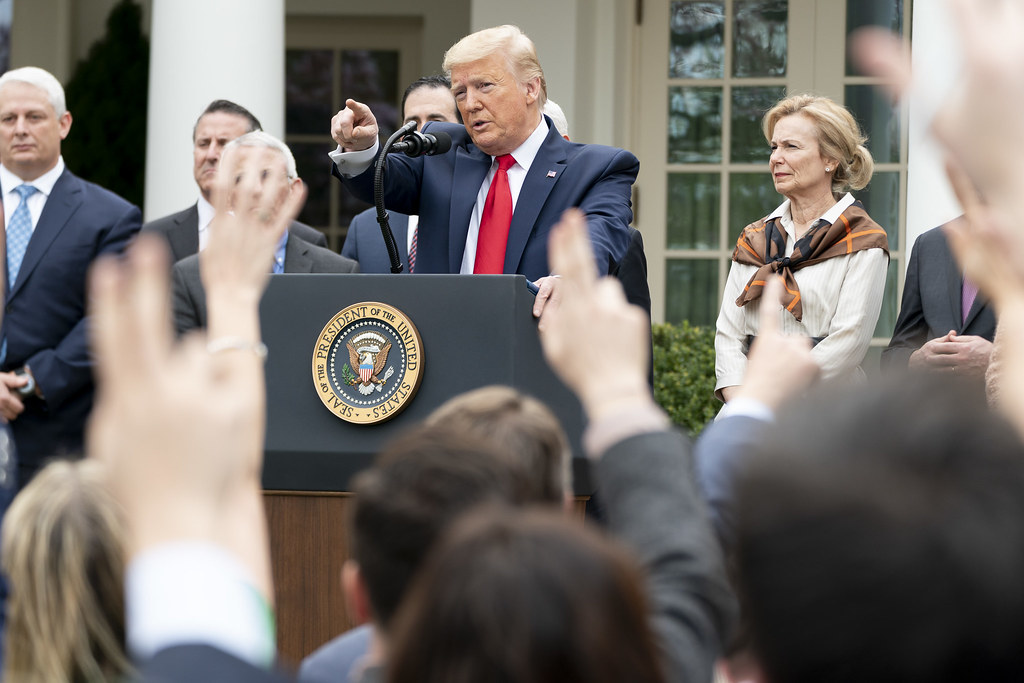What’s In Trump’s National Emergency Announcement on COVID-19?
The president's announcement includes one emergency declaration under the National Emergencies Act and one under the Stafford Disaster Relief and Emergency Assistance Act.

Published by The Lawfare Institute
in Cooperation With

On March 13, President Trump announced a national emergency in response to the coronavirus outbreak. The announcement includes two types of emergency declarations: one under the National Emergencies Act (NEA) and one under the Stafford Disaster Relief and Emergency Assistance Act.
National Emergencies Act Declaration
The first declaration relies on powers granted by Sections 201 and 301 of the NEA. Section 201 of the NEA authorizes the president to declare a national emergency, and Section 301 enables access to statutory emergency authorities not otherwise available. To exercise those statutory authorities, the president must specify the provisions of law under which he and other officials will act. Trump’s proclamation is relatively narrow, outlining three directives:
- First, the proclamation empowers the Secretary of Health and Human Services (HHS) to exercise authority under Section 1135 of the Social Security Act (SSA) to waive or modify certain requirements of Medicare, Medicaid, and State Children’s Health Insurance programs and of the Health Insurance Portability and Accountability Act Privacy Rule throughout the duration of the emergency. These waivers will loosen restrictions on telehealth usage and certain requirements for hospitals and healthcare providers so they can better respond to the crisis.
- Second, it requires the Secretary of HHS to provide advanced written notice of the waiver to Congress. As mandated by section 1135(d) of the SSA, this notice must include a description of the specific provisions that will be waived, the health care providers to whom the waiver will apply, the relevant geographic area, and the period of time for which the waiver or modification will be in effect. The proclamation states that its directives are consistent with the SSA’s requirements.
- Third, it clarifies that nothing in the proclamation should impair or otherwise affect executive branch authority or the functions of the Office of Management and Budget relating to budgetary, administrative, or legislative proposals. It also states that it does not create any substantive or procedural right or benefit enforceable by law.
The proclamation marks the beginning of the national emergency as March 1, 2020—12 days before the proclamation itself was released. A national emergency issued pursuant to the NEA can be terminated by a subsequent presidential proclamation or by a joint resolution of Congress.
The Stafford Act Declaration
Section 501(b) of the Stafford Act grants the president authority to declare a national emergency. Once an emergency is declared, the act allows state governments and tribal authorities to request disaster assistance from the federal government.
Typically, the Stafford Act is used to provide aid to states or localities damaged by natural disasters, like hurricanes or floods. However, it has been used at least once to respond to a contagious disease outbreak: President Clinton used the Stafford Act to respond to West Nile virus outbreaks in New Jersey and New York in 2000.
In its March 13 letter to the director of the Federal Emergency Management Agency (FEMA) and the secretaries of the Department of Homeland Security, Department of the Treasury, and the Department of Health and Human Services, the White House outlines the legal basis for its emergency declaration in response to COVID-19. The letter states that the federal government has the power to respond to a pandemic that began abroad under its authority to regulate interstate matters and foreign commerce and to conduct foreign relations—citing 42 U.S.C. § 264, which concerns regulations to control communicable diseases, as an example of that authority. In addition, the letter states, the federal government is responsible for securing the nation’s borders and controlling the entry of foreign nationals.
The letter then outlines the following directives:
- First, the letter allows FEMA to provide assistance under Sections 502 and 503 of the Stafford Act, which describe the scope and amount of federal emergency assistance. The declaration also instructs the FEMA administrator to coordinate and direct other federal agencies in providing assistance under the Stafford Act, though the Department of Health and Human Services will continue its role as the federal agency leading the response to COVID-19.
- Second, it encourages states and local governments to activate their Emergency Operations Centers––facilities that allow coordination of responses across state agencies and with the federal government––and review their emergency preparedness plans. Meanwhile, FEMA will continue to review how to provide assistance to states where possible.
- Third, it instructs the Department of the Treasury to provide relief from tax deadlines to Americans affected by the COVID-19 emergency. This relief is authorized under 26 U.S.C. 7508A(a), which grants the department authority to postpone certain deadlines when the president declares a national disaster.
- Finally, it states that requests for a declaration of a major disaster under Section 401(a) “may be appropriate.” Under Section 401(a), state governors or chief executives of Indian tribal governments must request a major disaster declaration based on their conclusion that the disaster is of “such severity and magnitude nationwide that effective response” is beyond the capabilities of the tribe or state. If the president grants a state’s request and declares a major disaster, he gains additional powers to respond to the emergency. He can, for example, direct a federal agency to use its authority and resources (including personnel, equipment, supplies, etc.) to provide relief assistance; provide technical and advisory assistance (including issuing warnings and public health information and performing essential community services); and assist in the distribution of medicine, food, and emergency assistance. The letter ends with an encouragement to governors and tribal leaders to consider requesting federal assistance under Section 401(a).
Earlier last week, Senate Democrats contacted the White House, urging it to provide disaster assistance under the Stafford Act if any state requested it.
Soon after Trump’s announcement, the White House also issued a memorandum on expanding state-approved diagnostic testing for the virus. The memorandum states that the secretary of HHS will take appropriate action to facilitate any requests from states for flexibility to authorize laboratories to develop and perform tests to detect COVID-19.


.jpg?sfvrsn=e915b36f_5)


